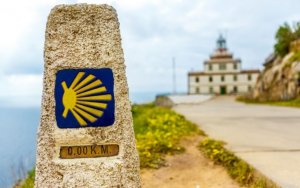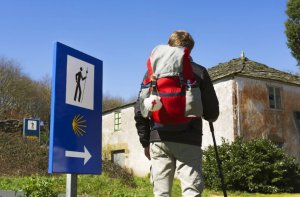5 Tips for Walking the Camino de Santiago

In Spain, there is a city called Santiago de Compostela, and it’s a Catholic pilgrimage attributed to the tomb of the apostle, James the Great. There are different roads that lead to Santiago, the most recognized is called the French Route. The city was declared a World Heritage Site by UNESCO in 1993.
Before the trip
Before you enjoy this experience, it’s important to plan your route well. The Camino de Santiago is a pilgrimage route with important historical value. It is always open to being traveled and the first thing you should do to plan your route, is to choose a path:
- French Route: 482 miles
- Portuguese Route: 74 miles.
- Vía de la Plata: 438 miles.
- Camino Primitivo: 167 miles.
- English Route: 96 miles.

You can choose a route that best suits your purpose. In addition to the distances, there are points on each route that are significant. Once you decide which path to take, put the following five tips into practice to make your journey more comfortable:
Active body all day
Long walks (especially those that start early) require the body to be adequately hydrated. Therefore, it is important that you hydrate before, during and after the tour. In addition, and because the route is long, you should not spend too much time at each stop. It’s also best to eat small portions of light food so that your digestive system is not working too hard.
Also, to prevent fainting or weakness, in addition to water or juice, you can bring candy. This is a small trick to keep you active during the day. Candies, chocolates, or nuts will keep you energized and help you on your journey to Santiago.
Small details matter
The smallest details matter in this type of activity. If, for example, your footwear bothers you, you’ll be suffering all the way through.
So choose appropriate clothes and proper footwear. You will need comfortable and light clothing during the summer. As for shoes, it’s best to wear closed, comfortable shoes that support the foot. A small tip to avoid blisters is to cover each toe with adhesive, this can be very helpful.
Also, carry sunscreen and mosquito repellent. It’s essential to pack a small first aid kit too. This is as a precaution for any minor incidents that may arise along the way.

Stretch before walking
When the body is subjected to physical activity with certain demands, (particularly if the body is not used to continuous physical movement) cramps usually appear.
To avoid them it’s important to stretch before starting the journey and after rest periods. When the body rests, it cools down. If you do not stretch before resuming the route, you will be prone to cramp.
Your own pace
Don’t push to maintain a certain speed. The only speed you need to meet is the one that your body allows you. A tip to maintaining a constant pace is with breathing. Maintaining good breathing is effective. If you begin to tire, don’t breathe through your mouth. Breathe in a controlled manner and through your nose. Whenever you feel it’s necessary, you can slow down and rest.
If you are very tired don’t stop immediately, this can cause dizziness and even fainting. If you are extremely tired, slow down gradually. Wait for your heart to stabilize its rhythm and then you can sit down and rest for a moment.
Short distances
As the body is not usually used to spending days walking, it’s important that you rest well when you stop. However, a trick to make sure that the Camino de Santiago won’t be an experience that leaves your muscles aching is to start with short stages. By starting with short stages the body will become accustomed and gradually you can increase the distance between the stages. This will make the journey more comfortable.
Ultreia et Suseia
Ultreia et Suseia is a saying that originates from Latin and it means ‘go ahead and beyond’. It’s a greeting traditionally used among pilgrims, and it’s also used to cheer each other up during the day. If another walker says, “Ultreia”, reply with “et Suseia!”
These five tips complement other important aspects that you must also take into account. Make sure the weight of your luggage isn’t more than 10 percent of your body weight, bring soap, identification, medication and other important items. Walking the Camino de Santiago is an extremely valuable experience.
Meet pilgrims, look at the landscapes, and reach Santiago de Compostela. But more importantly, you’ll create a connection between your soul, history, and art and everything else that the journey offers. This path can leave a trace that will never be erased. Love it, enjoy it, and live it!
In Spain, there is a city called Santiago de Compostela, and it’s a Catholic pilgrimage attributed to the tomb of the apostle, James the Great. There are different roads that lead to Santiago, the most recognized is called the French Route. The city was declared a World Heritage Site by UNESCO in 1993.
Before the trip
Before you enjoy this experience, it’s important to plan your route well. The Camino de Santiago is a pilgrimage route with important historical value. It is always open to being traveled and the first thing you should do to plan your route, is to choose a path:
- French Route: 482 miles
- Portuguese Route: 74 miles.
- Vía de la Plata: 438 miles.
- Camino Primitivo: 167 miles.
- English Route: 96 miles.

You can choose a route that best suits your purpose. In addition to the distances, there are points on each route that are significant. Once you decide which path to take, put the following five tips into practice to make your journey more comfortable:
Active body all day
Long walks (especially those that start early) require the body to be adequately hydrated. Therefore, it is important that you hydrate before, during and after the tour. In addition, and because the route is long, you should not spend too much time at each stop. It’s also best to eat small portions of light food so that your digestive system is not working too hard.
Also, to prevent fainting or weakness, in addition to water or juice, you can bring candy. This is a small trick to keep you active during the day. Candies, chocolates, or nuts will keep you energized and help you on your journey to Santiago.
Small details matter
The smallest details matter in this type of activity. If, for example, your footwear bothers you, you’ll be suffering all the way through.
So choose appropriate clothes and proper footwear. You will need comfortable and light clothing during the summer. As for shoes, it’s best to wear closed, comfortable shoes that support the foot. A small tip to avoid blisters is to cover each toe with adhesive, this can be very helpful.
Also, carry sunscreen and mosquito repellent. It’s essential to pack a small first aid kit too. This is as a precaution for any minor incidents that may arise along the way.

Stretch before walking
When the body is subjected to physical activity with certain demands, (particularly if the body is not used to continuous physical movement) cramps usually appear.
To avoid them it’s important to stretch before starting the journey and after rest periods. When the body rests, it cools down. If you do not stretch before resuming the route, you will be prone to cramp.
Your own pace
Don’t push to maintain a certain speed. The only speed you need to meet is the one that your body allows you. A tip to maintaining a constant pace is with breathing. Maintaining good breathing is effective. If you begin to tire, don’t breathe through your mouth. Breathe in a controlled manner and through your nose. Whenever you feel it’s necessary, you can slow down and rest.
If you are very tired don’t stop immediately, this can cause dizziness and even fainting. If you are extremely tired, slow down gradually. Wait for your heart to stabilize its rhythm and then you can sit down and rest for a moment.
Short distances
As the body is not usually used to spending days walking, it’s important that you rest well when you stop. However, a trick to make sure that the Camino de Santiago won’t be an experience that leaves your muscles aching is to start with short stages. By starting with short stages the body will become accustomed and gradually you can increase the distance between the stages. This will make the journey more comfortable.
Ultreia et Suseia
Ultreia et Suseia is a saying that originates from Latin and it means ‘go ahead and beyond’. It’s a greeting traditionally used among pilgrims, and it’s also used to cheer each other up during the day. If another walker says, “Ultreia”, reply with “et Suseia!”
These five tips complement other important aspects that you must also take into account. Make sure the weight of your luggage isn’t more than 10 percent of your body weight, bring soap, identification, medication and other important items. Walking the Camino de Santiago is an extremely valuable experience.
Meet pilgrims, look at the landscapes, and reach Santiago de Compostela. But more importantly, you’ll create a connection between your soul, history, and art and everything else that the journey offers. This path can leave a trace that will never be erased. Love it, enjoy it, and live it!
This text is provided for informational purposes only and does not replace consultation with a professional. If in doubt, consult your specialist.








